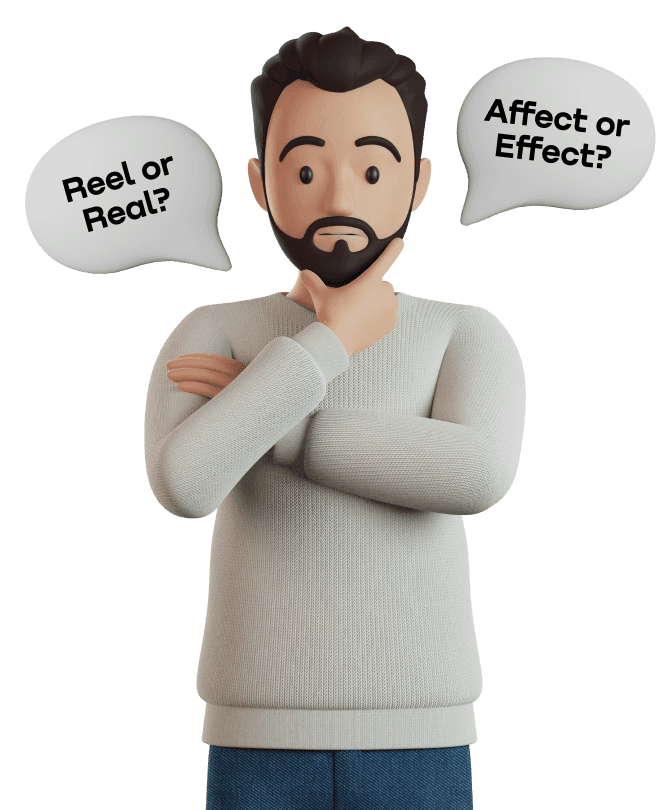Seen vs Saw
What’s the difference between them?

Seen
Meaning:
Past participle form of the verb 'see.' It means to have observed or noticed; to have perceived with the eyes.
Examples:
1. I haven't seen you in weeks, how are you?
2. I have seen that movie twice already.
3. Have you seen the new documentary on Netflix?
Saw
Meaning:
past tense form of the verb 'see.' In different contexts is also used as a verb that means o cut or shape something using a tool such as a saw.
Examples:
1. I saw a beautiful sunset this evening.
2. I saw the movie last night and it was amazing.
3. Give me the saw! I need to cut the last tree.
Learn similar and opposite words to spot the difference
Synonyms
Antonyms
Seen
Witnessed
observed
Unseen
Saw
Witnessed
observed
Unseen
Tricks for mastery
Useful tips to understand the difference between confusing words "Seen", "Saw".

1. Remember that 'seen' is the past participle of 'see,' so it's used in the perfect tenses. 'Saw' is the simple past tense.
2. Remember the phrase 'I saw it with my own eyes' as a reminder that 'saw' is the simple past tense of 'see.'
Practice English with the Promova app and avoid misusing confusing words
Frequently asked questions
When to use the first word 'Seen'?
The word 'seen' is mainly used as the past participle of the verb 'see', and it is used to refer to an action that was completed in the past. For example: 'I have seen the new movie.' It can also be used to indicate that something or someone is visible or has been noticed. For example: 'I have seen that the sky is very clear today.'
When to use the second word 'Saw'?
The word 'saw' is used as a verb to refer to an action that was completed in the past. It is mainly used when the subject of the action was the speaker or writer of the sentence. For example: 'I saw the new movie.' It can also be used to indicate that something or someone was noticed or seen. For example: 'I saw that the sky is very clear today.'
Do the words 'seen' and 'saw' have the same pronunciation?
No, the words 'seen' and 'saw' do not have the same pronunciation. The word 'seen' is pronounced with a long 'e' sound, while the word 'saw' is pronounced with a short 'aw' sound.
What are some common mistakes associated with the words 'seen' and 'saw'?
The most common mistake associated with the words 'seen' and 'saw' is confusing the two. The past tense of 'see' is 'saw', not 'seen'. Another mistake is confusing the two words in the present tense; 'see' is the present tense, not 'saw' or 'seen'. Lastly, some people may confuse 'seen' with 'scene', which is pronounced differently and has a different meaning.
Fill in the gaps to check yourself
1. I ____ him last week.
2. Have you ever ____ a shooting star?
3. He ____ a ghost in the graveyard.
4. I ____ the news on TV.
5. I ____ the sun rise this morning.
6. Have you ever ____ a whale?
1. Answer: Saw
Explanation: The verb saw is used when referring to something that occurred in the past.
2. Answer: Seen
Explanation: The verb seen is used when referring to something that happened in the past, but the speaker does not necessarily have a direct experience of it.
3. Answer: Saw
Explanation: The verb saw is used when referring to something that occurred in the past.
4. Answer: Saw
Explanation: The verb saw is used when referring to something that occurred in the past.
5. Answer: Saw
Explanation: The verb saw is used when referring to something that occurred in the past.
6. Answer: Seen
Explanation: The verb seen is used when referring to something that happened in the past, but the speaker does not necessarily have a direct experience of it.
Get a gift by subscribing to our newsletter!
Download the PDF with a list of commonly confused words made as flashcards for comfortable learning.
List of Commonly Confused Words
Finding your way around the English language can be hard, especially since there are so many confusing words and rules. So, a list of the most confusing words in English is an extremely useful tool for improving language accuracy and sharing the ideas clearly.